#i love this design of her because i want to push this... pop punk 70s chick as the grim reaper like hello that is so quirky
Explore tagged Tumblr posts
Note
may i request new wife 13 >:3
also hi ily

hi sky i also drew your mc because i love them. i hope you like it (#^-^#) ty for the request <3
#i hope i somewhat made them look like. your mc. if not you can kill me#also my thirteen is brown im sure you guys already expected it#i love this design of her because i want to push this... pop punk 70s chick as the grim reaper like hello that is so quirky#also i want to give her brown eyes but i think no one would recognize thirteen and be like jesus i fucking hate this blog they never#draw the characters how they actually appear -_-#anyway. SORRY i hope you have a wonderfulll dayyyyy <3 mwah#i finally am. DONE WITH SCHOOL !!!!!!!!!!!!!!!!!! so yes request whatever idc etc#but not now. because im finnaly going to watch. Jojo. SCREMAING AND CRYING.... JOLYNE..... AHHHHHHHHHHHHHH OK BYE JOJO TIME#request#doodle#obey me thirteen#obey me oc
38 notes
·
View notes
Text
Radical Reinvention – The Making of Edwige Belmore
History is kind to those who leave behind a tangible body of work. It is less so to those exuberant personalities that lived with great flair, but channelled their creative energy into more ephemeral modes of expression. Babette is fascinated with oral histories of these more fringe personalities in the history of art, design and pop culture. One of them is Edwige Belmore (1957–2015). A subcultural icon who criss-crossed between Paris and New York, Edwige played in several punk and new wave bands in the ‘70s and ‘80s (most memorably Mathématiques Modernes), starred in a spate of experimental films, was photographed by Helmut Newton and walked the runway for Jean Paul Gaultier and Thierry Mugler. And yet, no one of these things quite encapsulates (or contains) her legacy.
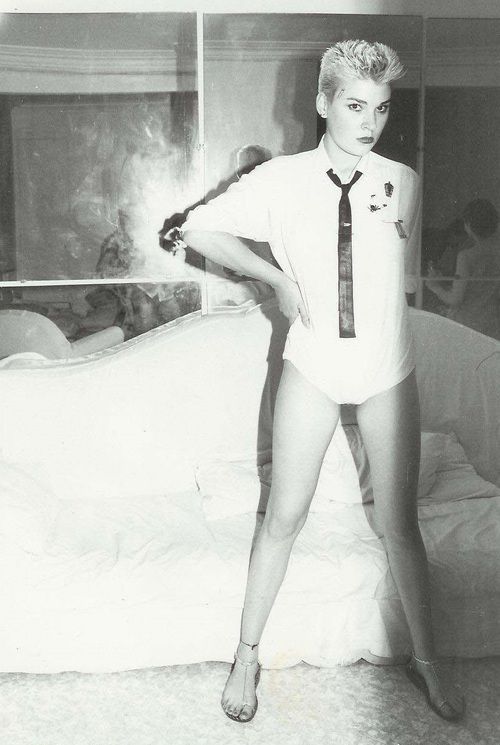
When Edwige worked as the Maitresse de Maison for French fashion house Agnès b’s New York store, she was told by a ‘friend’ “that it must be pretty cool to be paid for doing nothing”.“I’m not doing nothing,” she retorted, “I’ve been something for my whole entire life,”[1] and its that intangible ‘something’ that burns most brightly of Edwige’s legacy. Her essence. Her attitude. The way she presented herself to the world.
It is deemed shallow to suggest that someone be remembered for their ‘look’, but Edwige was no fashion plate. Rather, she used her body as her primary means of expression. With her cropped, peroxide blonde hair and a razor blade hanging from one earring, Edwige radicalised the Paris fashion world in the 1970s. She walked the tightrope between a DIY, street-punk aesthetic and high fashion: “She was punk with total elegance,” reflects videographer Clayton Patterson.[2] When top French fashion houses would gift her free items, Edwige would style them with her wardrobe of battered hand-me-downs. “I did a concert with Matématiques Modernes wearing jeans that were completely destroyed, a Chanel jacket and a push-up bra,” she told Italian Vogue before her death. “I didn’t want to be like every punk in Paris, or every punk around that dresses exactly the same.”[3]
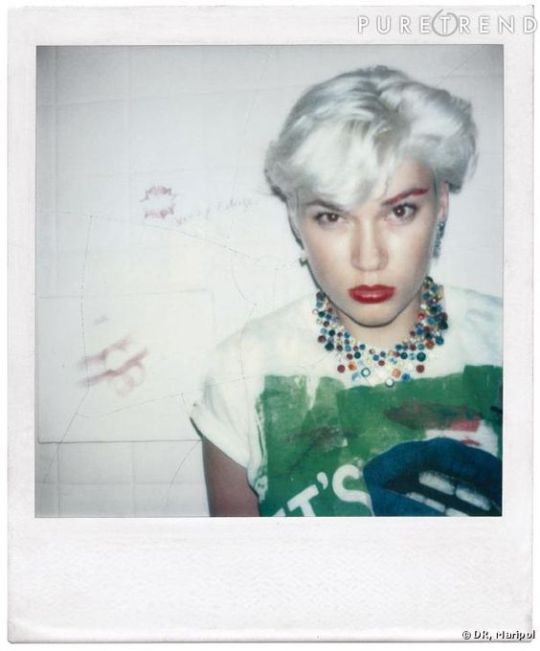
Edwige also pioneered a new aesthetic for queer women. She was openly bisexual, romantically linked to Sade and Grace Jones, and sported a playful combination of butch and femme aesthetics, teaming mannish suits with bright red lipstick. “She was the legendary lipstick lesbian,” photographer Marcus Leatherdale told New York Magazine.[4] When she spent six months in Japan in 1982, Edwige would sneak into the male-only sex clubs of Shinjuku, pretending to be a boy.[5] It’s hard not to imagine that the 1982 science fiction film Liquid Sky, with its androgynous lead Margaret (Anne Carlisle), a queer club kid with cropped, peroxide hair, is not at least partially inspired by Edwige.
This subversive aesthetic was not limited to clothing. Edwige took a diaristic, even confessional, approach to tattooing that was quite unique among her generation: “My tattoos are stepping stones in my life – moments, loves, fears, messages”.[6] Patterson reflects, “It was highly unusual for someone to have words and sentences on their body in the mid-’80s”[7] and in a eulogy published on the punk blog Please Kill Me, Sandra Schulman (a former lover of Edwige’s) recalls that Edwige’s tattoos “lined her thin arms and up her neck, scripted across her collar bone and trailed down her legs”. Many were part of a project in which “she asked all her friends and lovers to mail her a note in their handwriting and she would ink it onto her body.”[8]
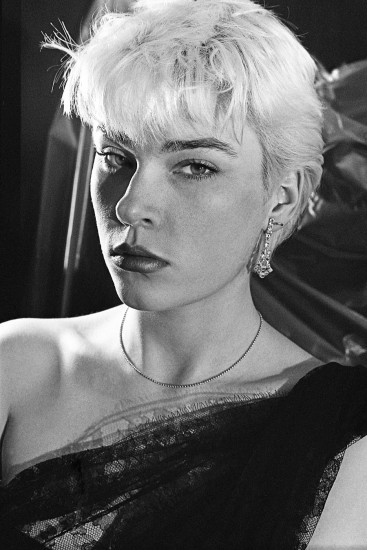
Edwige clearly saw her flesh as a canvas, but what is more provocative by today’s standards was not her tattoos, but the self-harm scars she wore unapologetically alongside them. Schulman describes bringing Edwige swimming at a New York health club: “In the women’s room she stripped down, strode around, and had the Village gym bunny ladies gasping at her scars, tattoos and boy/girl manner. Six feet tall barefoot.”[9] Patterson also remembers the scars: “She was such a beautiful woman, a Paris runway model, and to have her body modified like that was also very unusual.”[10]
Though self-harm was as taboo in the ‘70s and ‘80s as it is now, Edwige abided by an approach of candid honesty. “She told me that ‘everyone has a past’,” reflects model agent Kendall Werts, “but that the past will never define your future.”[11] In New York Magazine’s eulogy, friends and colleagues remark that Edwige’s acceptance of her flaws and contradictions was part of her powerful appeal. “She was a super-glamorous femme-butch dyke who was honest about her struggles with pain, with depression — but she never dumped that on anyone. In fact, she cheered other people up without lying about her own struggles,” says writer and artist Penny Arcade.[12]
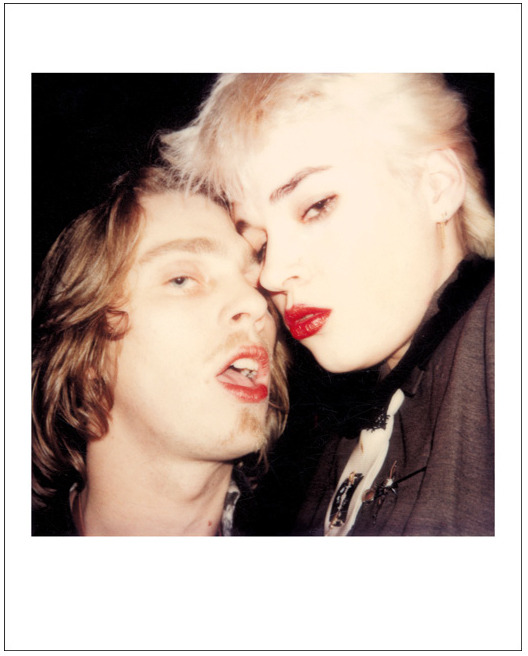
Edwige was candid about a great many things, and that includes her own ‘creation story’. In the few interviews with her available online, she recalls with earnest detail how she simply decided one day to reinvent herself and ‘become Edwige’. Abandoned by her parents at a young age (“They gave me $20 to have a life. They moved into the country side and I stayed in Paris,” she told Moco Loco in 2014),[13] Edwige was raised in a convent with little access to the music or subcultural movements of the early-1970s. That changed in 1976 when, aged 19, she saw the Sex Pistols perform live. It would prove to be a life-altering event: “No one at the time had SEEN anything like that! NEVER! It was the first MIND BLOWING new thing.”[14]
This brief exposure to the punk movement would inspire Edwige to reinvent herself with a remarkable degree of precision. “It was November 6 of 1976, I decided that in exactly a month from then that on December 6th: Edwige Will Die, and Edwige Will Be Born”.[15] True to her word, on December 6, she burned all of her clothing, bar one hand-me-down vintage leather jacket. “I decided to embrace that new movement … I wanted to be part of something. That was my family … I shaved my head, I burned all my clothes.”[16] She bought a pair of riding pants, a white shirt and a tie and took to wearing the same outfit day in, day out, like a uniform. “The real Edwige was born. The one before was shy, was ugly, was insecure, was scared.”[17]
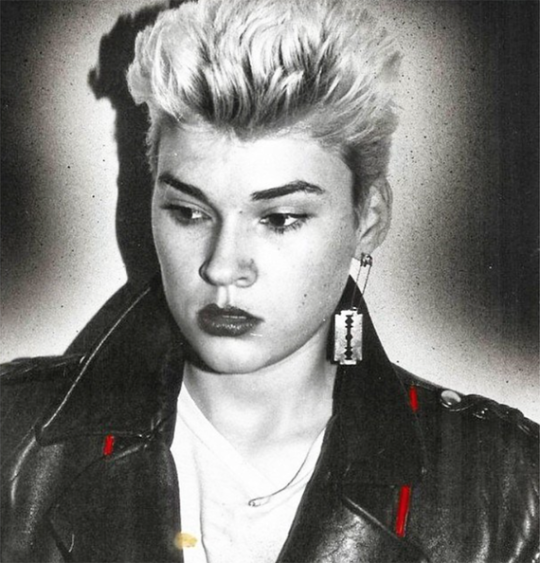
There is something remarkable about the agency Edwige took in her reinvention, or self-creation as it were. She is by no means alone among her generation in creating a new persona for herself, but unlike most ‘invented’ stars, she candidly acknowledges the constructed nature of this act, detailing the steps taken to become who she wanted to be. Much as Edwige’s flaws only added to her strength of character, revealing the constructed nature of her identity seems, to me, to add conviction to the act.
With ‘the new Edwige’ established, the next logical step was to join a punk band. It happened organically. “I was in a club and these two girls approached me and said, ‘Wow you look great! Want to be part of our band?’. I said ‘OK!’.”[18] The band was called L.U.V. (which could stand for either ‘Ladies United Violently’ or ‘Lipsticks Used Viciously’, as you please), and true to the ethos of punk, Edwige played no instruments. She did not let such a detail get in the way of her enthusiasm. Again, what endures of the band was their aesthetic: “We were a mythical band… We were FIERCE looking.”[19]
That fierce look was enough to attract press attention, with French Vogue and Elle clamouring for interviews, and Edwige quickly emerged as the poster girl of the Parisian punk movement. In 1977, the publishers of French avant-garde magazine Façade (inspired by Andy Warhol’s Interview) invited her to grace its cover – starring alongside no other than Andy Warhol. In the magazines wrap-around cover and inside spread, the peroxide-blonde Edwige leans in and kisses an unperturbed Andy, who dons a pin-badge of her image on his lapel. The headline? The Pope of Pop meets the Queen of Punk.
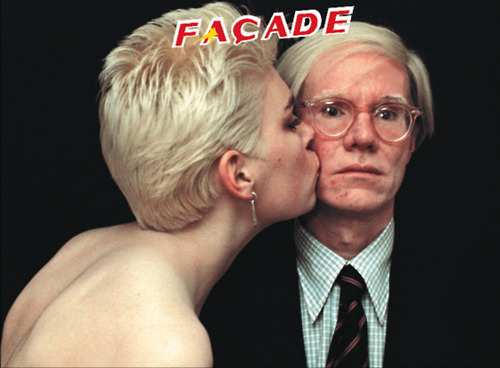

With Andy Warhol for Façade, Paris, 1977
Edwige recalls of the shoot that she spoke very little English at the time – and Andy no French – but the pair managed to strike up a rapport via instinctive, non-verbal communication. When she travelled to New York later that year, she gave Andy a call, and he brought her along to Studio 54. “Approaching the illustrious nightclub of all nightclubs, swathes of partiers parted like the red sea as she entered the club for her very first time, arm-in-arm with her regal rebel counterpart,” reports Autre Magazine.[20]
This ultimate outsider quickly found acceptance from the ultimate insiders of New York and Paris. Brought to a party by Paloma Picasso, she was spotted by Helmut Newton who, rumour has it, persisted to follow her around the party, begging to photograph her. She relented, but insisted she was photographed “not as a model, but as a personality.”[21] She also sat for Francesco Clemente, who painted her with “eyes half closed and completely blue … I was nodding out or on drugs. Blue, blue, blue, blue!”[22]

With Helmut Newton, 1986
Upon her return to Paris, Edwige was appointed front-of-house at Le Palace, the city’s answer to Studio 54, where the staff wore crimson and gold tunics designed by Thierry Mugler and Grace Jones performed atop a pink Harley Davidson on the opening night. Everyone from Yves Saint Laurent to Roland Barthes came there to party, and Edwige’s job was essentially to decide who would be permitted entrance. She took the same, seemingly contradictory, approach to the door policy as she did her fashion choices, creating a mix of elite and punk, gay and straight, black and white, rich and poor. “Karl Lagerfeld mentioned in his book that I once refused the King of Sweden because obviously, he must have been an asshole.”[23]
Its perhaps in this role – the high/low gatekeeper of Parisian nightlife – in which Edwige is most fondly remembered. When she died in 2015, tributes came flooding in on social media. One of the most substantial homages to Edwige to date has been Jean Paul Gaultier’s Spring/Summer 2016 couture show, which was both inspired by and devoted to his late muse. Gaultier’s collection was a 70s-inspired romp of butch tailoring, femme sequin jumpsuits and sassy models. “Red lips, fishnet tights, lamé; gold leggings, white gloves it was all about attitude, attitude, attitude,” read the review by British Vogue.[24]

Jean Paul Gaultier’s Spring/Summer 2016 couture show, a tribute to Edwige, complete with mock Le Palace façade, an Edwige-inspired ‘bouncer’ and lesbian trysts with runway models
The show opens with a lesbian tryst between a runway girl and an androgynous pixie-cropped model who starts manning the door of a club, a replica of ‘Le Palace’. The parade of models who sashay up and down the runway includes Anna Cleveland, daughter of legendary model Pat, who Edwige surely must have rubbed shoulders with at Studio 54. The girls bring their cigarettes and glasses of champagne along for the walk, stopping to air-kiss one another (or catfight) en route. For the finale, the our queer heroine pulls door-girl ‘Edwige’ inside ‘The Palace’. The curtains descend and reveal the full crew of models, accompanied by Mr Gaultier, dancing, laughing and drinking champagne to the sound of Amanda Lear’s ‘Fashion Pack’.
If heaven looks like this, I do hope they let me in.
Babette, 25.08.17
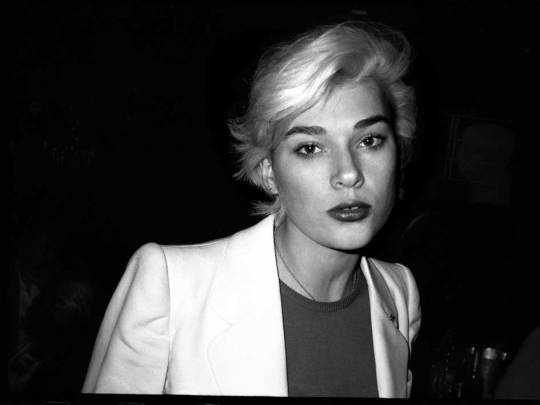


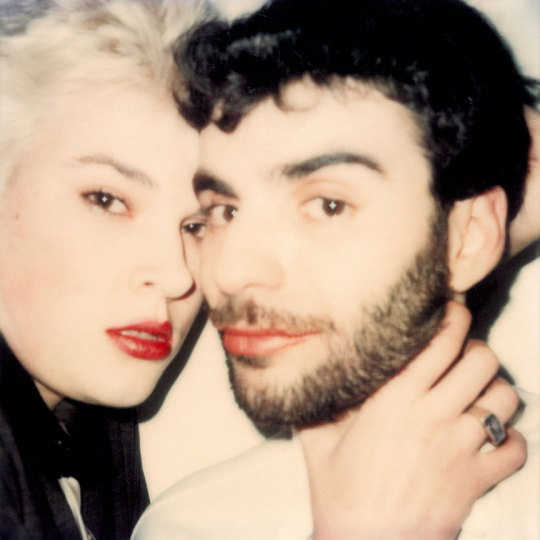

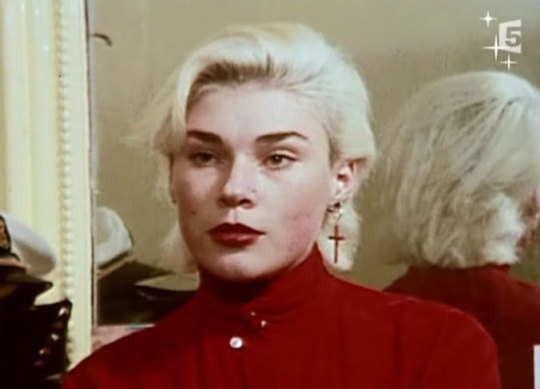
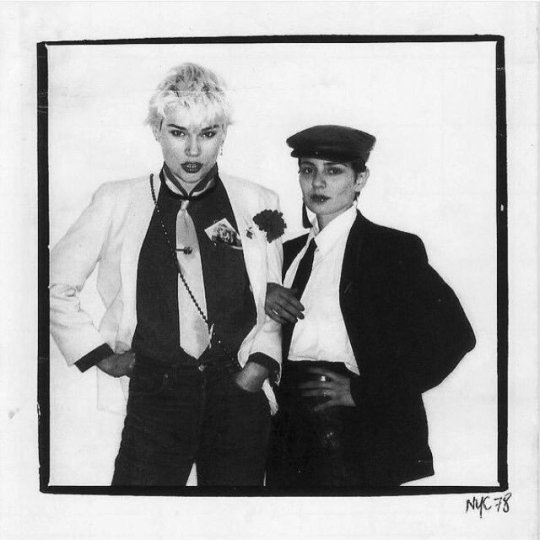

FOOTNOTES
[1] Edwige Belmore, quoted in Eepmon, ‘In Conversation with Edwige Belmore, The Queen of Punk Pt.2′, Moco Loco, 31 December 2014, accessed online at http://mocoloco.com/in-conversation-with-eepmon-edwige-belmore-the-queen-of-punk-pt2/ on 19 August 2017
[2] Clayton Patterson, quoted in Walter Armstrong, ‘The Life of Punk Queen Edwige Belmore and the Death of the Old Downtown’, New York Magazine, 25 September 2015, accessed online at http://nymag.com/daily/intelligencer/2015/09/edwige-belmore-death-of-a-punk-queen.html on 19 August 2017
[3] Edwige Belmore, quoted in a video interview with Barbara Frigerio, ‘Focus on: Edwige Belmore’, Vogue Italia, 4 July 2011, accessed online at http://www.vogue.it/en/people-are-talking-about/focus-on/2011/07/edwige-belmore#ad-image102614 on 19 August 2017
[4] Marcus Leatherdale, quoted in New York Magazine, ibid.
[5] Moco Loco, ibid.
[6] ibid.
[7] Patterson, ibid.
[8] Sandra Schulman, ‘Death of a Glamazon. A Tattooed Love Letter to Edwige’, Please Kill Me, 26 September 2015, accessed online at http://pleasekillme.com/death-of-a-glamazon-a-tattooed-love-letter-to-edwige/ on 19 August 2017
[9] ibid.
[10] Patterson, ibid.
[11] Kendall Werts, quoted in New York Magazine, ibid.
[12] Penny Arcade, quoted in New York Magazine, ibid.
[13] Edwige Belmore, quoted in Eepmon, ‘In Conversation with Edwige Belmore, The Queen of Punk Pt.1′, Moco Loco, 31 December 2014, accessed online at http://mocoloco.com/in-conversation-with-eepmon-edwige-belmore-the-queen-of-punk-pt1/ on 19 August 2017
[14] ibid.
[15] ibid.
[16] Vogue Italia, ibid.
[17] ibid.
[18] ibid.
[19] Pt.1, Moco Loco, ibid.
[20] Summer Bowie, ‘Beautiful Vagabond: 10 Things You Need to Know About the Late Edwige Belmore’, Autre Magazine, 24 September 2015, accessed online at http://autre.love/this-and-that-main/2015/9/24/beautiful-vagabond-10-things-you-need-to-know-about-the-late-edwige-belmore on 19 August 2017
[21] Pt.1, Moco Loco, ibid.
[22] Pt.2, Moco Loco, ibid.
[23] Nick Vogelson, ‘In Memory: Edwige Belmore, Our Lady of Punk’, Document Journal, 22 September 2015, accessed online at http://www.documentjournal.com/article/in-memory-our-lady-of-punk on 19 August 2017
[24] Ellie Pithers, ‘Spring/Summer 2016 Couture: Jean Paul Gaultier’, Vogue, 27 January 2016, accessed online at http://www.vogue.co.uk/shows/spring-summer-2016-couture/jean-paul-gaultier on 19 August 2017
#edwige#edwige belmore#punk#subculture#studio 54#le palace#jean paul gaultier#couture#paris#new york#club kids#Mathématiques Modernes#queer#bisexual#lesbian#peroxide#new wave#coldwave#Agnès b#tattoos#self-harm#reinvention#andy warhol#façade magazine#helmut newton#butch#femme#fashion
24 notes
·
View notes
Text
Visual and Cultural Hierarchies
Noel Fielding
Fielding claims that he could never make a choice between fine art and comedy, it was always his ambition to make comedy with an art-school slant, and art that could be funny instead of po-faced. His work resembles that of someone who’s subconscious is very close to the surface, reality and imagination is constantly the same. Fielding’s artwork was the first contemporary paintings I ever really understood, they ultimately drove to me to start making my first serious pieces of work- by serious I mean completely ridiculous morphs of my friends and blocks of cheese as I’s imagined in a dream. Fielding is extensively important as a reminder that art doesn’t always have to be quite so serious and political, it can be themed by nothing other than spontaneity, it can be whatever you’ve got knocking about in your head right at that moment.
Martin Parr
Martin Parr is one of Britain’s most significant photographers, best known for his sharp eye and sense of humour. Over his thirty-year career he has focused on capturing ordinary people doing ordinary things – at the seaside, in supermarkets, at village country fairs or on holiday abroad. Often highly saturated and brightly coloured Parr has become known as a commentator and recorder of Britain’s finely nuanced class system. His series ‘Signs of the Times’, based on the TV series of the same name, directed by Nick Barker, is a vintage look at personal taste in the British home, exploring the extraordinary range of emotions that lie behind our household decor. Parr's photography complements Barker’s survey of contemporary perceptions of good and bad taste.
Grayson Perry
Grayson Perry is an English contemporary artist who is known for his ceramic vases, tapestries and cross-dressing, as well as his observations of the contemporary arts scene. Perry's vases have classical forms and are decorated in bright colours, depicting subjects that juxtapose with their attractive appearance. There is a strong autobiographical element in his work, in which images of Perry as "Claire", his female alter-ego, and "Alan Measles", his childhood teddy bear, often appear. Grayson Perry has been cross-dressing since he was a child, using it to step into a fantasy world where he felt safer. He describes himself as a transvestite and for him cross-dressing has an exciting, sexual aspect but he has no desire to become a female, nor to dress as a woman full-time. After many years of experimenting with cross-dressing and wearing conventional female clothes, Grayson became dissatisfied with the lack of reaction he provoked. In response, he developed the persona known as Claire, as her he can dress in an outrageously flamboyant way and enjoy the reaction she causes. Perry represents the important comedic element of drag, it is an art form but it shouldn’t always been taken seriously. Drag is a safe space but also a production of femininity, whatever you want femininity to be. Perry has inspired my future drag project greatly.
Nadia Lee Cohen
Nadia Lee Cohen's photographs and films, heavily inspired by Americana and Britain in the 1950’s, 60’s and 70’s, are veritable visions of saturated, surreal dreamscapes. Drawing upon the duality of the female form, fine art photographer and filmmaker Lee Cohen locks our optics upon the twisted paradise that lurks within her mind. She explores the paradoxical standoff between strength and fragility within womankind. Lee believes in living within her work and has gained notoriety through her quirky colourful online presence on social media; in which she plays dress up and curates interesting imagery of her day to day inspirations. My own work with film photography and photomontage is most notably influenced by Lee Cohen depictions of confused domestic scenes in her short films.
John Waters
John Waters is an American artist best known for his satirical and raunchy movies. He is also a visual artist, Waters’ photography, sculpture, and installations pieces humorously recontextualize art and popular culture. Born in 1946 in Baltimore, Waters briefly attended NYU for film but was kicked out for what he claims was the “first ever marijuana scandal on a university campus.” Waters then returned to Baltimore in 1966 where he began collaborating on films with his long-time friend and muse Harris Glenn Milstead, also known as Divine. He gained a cult following in the 1970s with his transgressive films Pink Flamingos (1972) and Female Trouble (1974), as well as the box office hit Hairspray (1988). In his 50-year career Waters has accrued an enviable array of hideous honorifics, all worn with pride as he mocks those who look to certain subcultures with vulgarity, by presenting them in the most grotesque ways imaginable.
Linder Sterling
Linder’s photomontage aesthetic lent itself to the DIY philosophy of Punk: layering images, body politics, feminist discourse and the referencing of historical events. Her work draws on influences from Dadaism, Surrealism and Old Master paintings; and from fashion photography to performance art. A radical feminist and an active figure of the Manchester punk and post-punk scene, Sterling is known for her photomontages which combine images found in pornographic, fashion and interior design magazines, as well as from print documentation of ballet and film. Sterling's works often highlight the cultural expectations of women and the exploitation of the female body as pure commodity. When she first started creating these photomontages, many of her works were published in the post-punk photomontage fanzine 'The Secret Public'.
Martha Rosler
Martha Rosler's biggest contribution to the art world lies in her ability to present imagery that spotlights the veil between facade and reality, comfort and discomfort, and the myriad ways we keep our eyes wide shut or wide open. During the Feminist art movement of the 1970s, she explored the imposed versus exposed injustices of being a woman. As a member of the Pop art movement, she highlighted the media's targeted seduction of people into a more consumerist-driven lifestyle. Today, she continues to focus on our still inbred aptitude for replacing dire global realities such as war with fluffy faux-reality distractions like reality television and advertisement-driven personal entertainments. Her work often focuses on political issues such as war or injustice but in a way that challenges us to bring these topics into a more personal sphere, not just relegated to the pages of a magazine or a prime time news report. She asks us to pay attention to what is happening even if it is not occurring within our own environments and to consider the role that the media has in controlling how we perceive world events. Rosler became a leading figure in the Feminist art movement because much of her work revealed the divide between how women were portrayed as individuals whose only place was within the confines of home, marriage, kitchen, and motherhood and the way they actually felt by being pigeonholed into said domestic roles. She also used brave new technologies such as video to differentiate herself from the male art stars and their traditional mediums that had come before.
David Lynch
David Lynch is an American filmmaker, television director, visual artist, musician and occasional actor. Known for his surrealist films, he has developed his own unique cinematic style which has been dubbed "Lynchian" and is characterized by its dream imagery and meticulous sound design. The surreal and, in many cases, violent elements to his films have earned them the reputation that they "disturb, offend or mystify" their audiences. What Lynch sees, and then puts on screen for viewers to see, is one of the great enigmas of cinema, one that has launched a thousand film studies PhDs. When he looks at a manicured lawn, his mind’s eye tunnels beneath it to hidden mystery, mysticism and depravity – visions he has turned into mind-bending television and film. It’s an oeuvre people tend to love or detest, and even devotees don’t claim to fully understand.
Amanda Charchian
Amanda Charchian creates work with a feminine sensuality that is simultaneously epic and intimate. In 2018 she exhibited a new body of work at Fahey/Klein Gallery entitled "7 Types of Love" which presents mediations on the seven categories of love as described by Canadian psychologist John Allen Lee based on Greek ideas. Her photographs create visual narratives on romantic, spiritual and dutiful love through a feminine lens. Charchian captures intimacy and the connection between herself and the women she photographs translating the subtlety of the moment. I most value the delicate and warm nature that she presents women in along with her view that inforcing themes can be restrictive and arbitrary; her photography is about capturing vivacious characters, the charm, the mystery, the strange thigs that make these women individual.
Ellen Von Unwerth
Unwerth is one of the most noted fashion photographers in the industry, pushing the limits of female sexuality. The model turned photographer has now shot for all of the of top fashion publications including Vogue, Vanity Fair, Interview, The Face, Arena, and i-D, and published dozens of books of personal work from exhibitions around the world. Unwerth has an innate ability to capture female sensuality in any setting by relating to the model’s state of mind and her confidence in female playfulness and sexuality. I am hugely appreciative of her role in the fashion world in making women feel comfortable with their sexuality thus confident in themselves and their talent. Unwerth is consistently using her voice to help further the stature of other females.
0 notes
Text
Why men's voices are vital in Ireland's abortion referendum
New Post has been published on http://asylumireland.ml/why-mens-voices-are-vital-in-irelands-abortion-referendum/
Why men's voices are vital in Ireland's abortion referendum
Male allies in politics, the creative scene, and all walks of Irish life are stepping up alongside women to fight the system that oppresses them
‘Ireland Unfree’ is a Dazed mini-series telling the stories of Ireland’s bold fight for abortion rights, in the run up to the monumental referendum on the eighth amendment. Stirring protest, creativity, personal politics, and vital conversation, these Irish people push for autonomy. Here, we share their journey on Dazed.
The death of Savita Halappanavar in 2012 had an earth-swallowing feel to it. Denied of the basic healthcare required to ensure her survival, a constitutional amendment deemed her life – 31 years of complex human love, colour, and learning – of the same value as a 17-week-old fetus. She died in Ireland’s University Hospital Galway in Ireland due to the complications of a septic miscarriage. Her husband, Praveen, was dutifully left to channel her lost voice and carry her legacy on his already burdened shoulders.
On Friday May 25, Irish citizens will go to the polls to determine if the controversial Eighth Amendment of the Irish Constitution, which equates the right to life of the mother to the unborn, should be removed and repealed. The amendment, which criminalised abortion in almost all cases, was brought about as a result of a 1983 referendum, a time when the Catholic Church in Ireland was still very much an arm of government. Divorce was still illegal. Contraception was a taboo. Homosexuality remained outlawed.
The Irish man, of course, has no such lack of bodily freedom. Yet, about 70 per cent of Irish women who receive abortion care in the U.K. are married or with a partner. That is, conservatively speaking, thousands of fathers and partners that the Eighth Amendment has, too, bound to secrecy and shame.
Actor and author Emmet Kirwan – who last year created the beautiful spoken-word short film Heartbreak – views the redressing of Ireland’s wrongs broadly and disputes any sense of moral responsibility on individual men. “It’s not just a binary issue of males versus females: It’s an institutional issue,” he tells me. “Whether they be governmental, health, Church – all various arms of the state. There has been an institutionalised gender bias.”
youtube
On Irish streets, in local bars, on shop corners, through headlines painted across newspapers and hashtags proliferating via social media posts – there is a bitter political divisiveness that this debate has wrought, a clearly-defined chasm that calls other political ruptures of late to mind. No wonder there have been questions of sinister outside interference akin to the Cambridge Analytica scandal. In response, micro-campaigns have popped up all over social media – necessary conversation-sparking tools.
Ger Murphy, a 35-year-old events manager from South-Dublin, decided that Irish men needed to contribute to the dialogue around abortion rights. A conversation that, without question, needed their support. In late February, he founded the Men For Repeal Facebook page – ‘balls to the 8th’ is its light-hearted but defiant URL – after some troubling conversations about male engagement. Murphy sought to, at minimum, challenge the many outspoken men on the other side of the debate.
A large subset of the Irish male population, Murphy tells me over the phone, feel this is not their vote, that this a women’s issue that has no true bearing on their existence. Outside of the reality of crisis pregnancies which routinely affect women everyday, the idea that it’s a women-only issue is misguided, disingenuous, and, frankly, outdated. In truth, indifference largely translates as pro-choice.
“Whether they be governmental, health, Church – all various arms of the state. There has been an institutionalised gender bias” – Emmet Kirwan
“There is no problem in coming out and saying there is a male aspect to this issue. The vast amount of women would agree that the men in their lives are being affected as well,” Murphy says of the messaging. “The left trips over itself sometimes trying to be too PC about these things.”
Complacency is participating in neither debate nor democratic process, and it’s something to be concerned about. Kirwan, one of the most vocal Irish artists, explains there are no excuses for liberal-minded men eschewing their right to vote in the referendum: “The kind of passive, non-participation is essentially giving the vote over to the other side. This kind of idea that you can affect change by doing nothing; it’s a logical fallacy.”
Gordon Grehan of the Transgender Equality Network also tells me that repeal is “imperative to ensuring the rights of all people who can become pregnant, including trans men and non-binary people”. He adds: “As a trans organisation, we know the importance of ensuring self-determination, bodily integrity and physical autonomy.” As previously detailed in Brian O’Flynn’s report on the pro-choice campaign’s push for inclusivity, marginalised people like trans men who can get pregnant must be included in the conversation.
I’ve listened to women’s stories they deserve better. A No vote won’t stop abortions but continues the hypocrisy, shame and stigma. A Yes vote moves us to fairer, safer, more compassionate healthcare in Ireland. It’s our responsibility to put the hand out to our women. #men4yes
— Eamon Mc Gee (@EamonMcGee) April 24, 2018
So glad to see #men4yes emerge. I’m voting yes because, as a man, there is no medical procedure unavailable to me to protect my life or my health. I want the same for women.#TáDoMhná
— Aodhán Ó Ríordáin (@AodhanORiordain) April 24, 2018
Men For Repeal, along with Lads For Choice, have thrust the conversation of male engagement directly into the national discussion with Together For Yes, the campaign in favour of repeal. Through the #menforyes hashtag, men online have told their uniquely positioned and shared stories of loss, shame, and state-sanctioned oppression. One such story, which was posted by Men For Repeal’s Facebook page earlier this month, attributed to a man named Enda, illustrates the culture of shame embedded in Irish society.
Enda’s mother – empowered by his coming-out as gay – confided in him that she had an abortion pre-marriage, but for fear of judgement, had told just Enda and one of her sisters. “She’d felt sure that my grandfather would disown her for having sex outside of marriage and he died never knowing,” Enda writes. “I remember her saying she felt as if she was damaged goods with my own father, and had been terrified of telling him in case he no longer wanted to marry her.”
Elsewhere, Murphy alludes to meme culture (check the Ireland Simpsons Fans page for some of the best) and the use of internet spaces as a shareable access point for men, more so for those that are tentative or unsure about their place in a large, fast-moving campaign. Murphy’s resourcefulness also helped him develop a video series where male musicians cover female artists.
via Ireland Simpsons Fans
Creativity in the arts has propelled much of Ireland’s political movements, and the Repeal Project is a major example. The monochromatic sweatshirt – simple, inclusive, and unisex – is boldly inscribed with ‘Repeal’, now iconic in Irish millennial culture as a statement of aesthetic defiance. Repeal founder Anna Cosgrave recently guest edited local music and culture magazine District with the ���Men’s Issue’ of its Dublin City Guide. The issue profiles male Irish allies across sport, music, film, and politics. Dance music magazine and online community Four Four has been passionately supportive of repealing the 8th on its pages.
Dublin’s vibrant young music scene sees lyrics that continue to reflect Ireland’s bewildering reality, from DIY punk to burgeoning R&B. Rising Dublin hip-hop act, KOJAQUE, recently rapped: “Sovereign state; they’d rather see my mother bleed out than build a clinic.” Elsewhere in the fashion world, designer Richard Malone has been an outspoken supporter for repeal, taking over Selfridges’ window display to write messages of support. In a powerful open letter for Vogue, Malone describes the “infuriating and unjust treatment of women” he has witnessed at home, the misinformed, Catholic-based education about sex and abortion he and his generation received, and the social and class structures that hinder women’s right to choose. “We have to use our vote to speak for ourselves and for the generation of young people coming directly behind us,” he writes, “who remain voiceless in the votes on their future.”
Toxic masculinity is seriously affecting Irish young men’s mental health, sexuality, and attitudes towards sex, the latter manifesting itself in one of the most widely reported and divisive public trials in Irish history: the rape case involving Ulster Rugby stars Paddy Jackson and Stuart Olding.
The voice of brusque social sensibility in Ireland today, Blindboy Boatclub of Irish comedy duo Rubberbandits is in equal parts an absurdist and a realist. He’s become an unofficial spokesperson for these disenfranchised young men, men who accounted for 80 per cent of Irish suicides last year. With one of the highest percentages of teen suicide in Europe, a silent epidemic pulses through Irish society.
youtube
During a revealing 2016 interview on Ireland’s The Late Late Show, Blindboy asserted that feminism is, in fact, a remedy for male-centric mental health issues and toxic masculinity, something that rings through with this referendum and long afterwards. “I have nothing to offer a woman, I have nothing,” he says of young men’s attitudes in Limerick, his native city. “How am I supposed to provide for a woman? The fact of the matter, is that that is a patriarchal attitude that is no longer relevant to us in the 21st century.” Blindboy has become a pivotal voice in the movement; utilising social media and his increasingly popular podcast to speak to men directly. His recent book, The Gospel According to Blindboy, delves deeply into such issues – he’s a leader, and a cultural reckoning force behind the pro-choice movement.
In a more recent filmed conversation with Cillian Murphy, Blindboy and the actor rallied for men to excercise their right to vote. “Men and women are both custodians of this society…we need to go out and support women,” Cillian Murphy said.
For too long, Irish women have been defined by their struggle. Those single mothers, those women who claim asylum under Ireland’s dehumanizing Direct Provision system, women of disparate colours and backgrounds, those with varying sexual identities and disabilities: it’s a vote for all women, and now isn’t a time that men can be complacent or indifferent. May 25 gifts Irish citizens – men equally – the opportunity to right one of our nation’s great wrongs. Though cis men will never know what it is like to carry a pregnancy, men are inextricably linked to this upcoming referendum. Men have a duty to engage with, support, and amplify female voices and stories so that an experience like Savita and Praveen’s is never relived again.
, http://www.dazeddigital.com/politics/article/40058/1/why-mens-voices-are-vital-in-irelands-abortion-referendum
0 notes
Text
FEATURE: Humanity's Worst, Front and Center on the Anime Stage
Humanity's Worst, Front and Center on the Anime Stage
By Ian Mertz
There is a sadistic thrill that comes with watching people acting against our ingrained sense of morals, or better yet, against society's standards of good in favor of our secret rebellious desires. When Lupin the Third came on the anime scene in the early 70's, with its titular pragmatic thief, it was a huge shift from the model of protagonists who embodied the forces of absolute moral good. Even the punks who so often popped up as the stars in early sports classics brought a bit of that wild side out in the show, let alone more aggressively amoral characters like the swashbuckling interstellar Cobra or the hitman Golgo 13. Flash forward to 2017, and as if an old otaku made a poorly worded deal with the devil we got a season of protagonists who moonlight as terrible human beings, with both hilarious comic headliners and bone-chilling pragmatists coming to call. These are their stories.
KONOSUBA -God's blessing on this wonderful world! 2
Back in the 80's and 90's, prominent writers such as Rumiko Takahashi and Yoshihiro Togashi noticed that if they wanted to make their protagonist funny, one thing they could do is make their protagonist kind of a dick. Characters like Yu Yu Hakusho's Yusuke Urameshi, Ghost Sweeper Mikami's Tadao Yokoshima, and Urusei Yatsura's Ataru Moroboshi were all generally moral people, but had many of the failings one would expect of a teenage boy: perverted, insensitive, and just generally causing trouble. Again, they had a baseline morality usually shown through their devoted love interest, who indirectly acted as their anchor, someone who brought out the best in our hopeless hero.
The first show on our list, KONOSUBA -God's blessing on this wonderful world!, tosses that morality out the window, and instead of a love interest just lets the whole harem get in on the amoral fun. Adventurer Kazuma Satou is just as lecherous and abrasive as any rom-com hero, but instead of a soft spoken heroine to bring out the non-existent goodness in his heart, he gets three companions at least as bad as him. It turns out having characters who are generally good on the inside is better for character development and storytelling, but when you take that away from them the result is plain hilarious, especially with the sense of comedic timing the show has honed over its last season.
Of the three the show mostly centers on Aqua, the goddess Kazuma forcibly brought on his adventures. She is the only one in the show with a tongue as sharp as Kazuma's, and neither of them will let the other's failures go unnoticed, nor their own successes go without a good long stretch of gloating. When Aqua purifies a great spirit rooted to the world against his will, she spends the rest of the episode reveling in her almighty powers as a goddess right in front of Kazuma's face; when it turns out the purification also set a horde of monsters upon the city in the process, Kazuma's insults bring her to the verge of tears.
The other two provide endless fuel for Kazuma's morally abhorrent personality too. While the masochistic holy crusader Darkness left the center stage for a while at the start of this season's KONOSUBA -God's blessing on this wonderful world! 2, she is back and in rare form, having gone so far into the realm of fetishizing her own pain and humiliation that Kazuma can no longer even insult her without feeding her complex further. The crowd favorite, the explosion junkie Megumin, has also been stepping up as perfect fodder for Kazuma this season. It's a mark of both great writing and the author's particular penchant for creating human trash when the show's greatest exposition thus far this season is that Megumin spent her younger years taking some kid's lunch money after class.
Masamune-kun's Revenge
And maybe it's a mark of a good anime season that she isn't the only character stealing people's lunch. One of the more popular romantic comedies this season, Masamune-kun's Revenge features a burgeoning couple who would be right at home with the KONOSUBA -God's blessing on this wonderful world! cast. I say burgeoning because they aren't a couple at the start of the story, nor do either of them like each other, and not in a simple Ranma ½ -style tsundere mismatch. Masamune Makabe wants nothing more than to be asked out by the school idol Aki Adagaki, who is notorious for hating men and rejecting them in cruel and mortifying ways. His motivation? To mortify her right back, the girl who teased him when they were kids. He completely reworked his appearance to the point where he's a heartthrob among the girls, but he passes up his chances at love for that one shot of sweet karmic justice.
And despite how comically petty he is for even trying, Aki sells herself as such a terrible person that we can't even blame him. Besides sticking all the boys who ask her out with insulting, albeit meticulously researched, monikers, she also eats both her share of lunch and most of her best friend's bread on top. Good for her that she eats healthy, but the self-absorbed way she orders her friend to buy her more food, away from the prying eyes of the other girls who respect her so highly, makes us want Masamune to take her down a peg too.
Or such is the premise. In reality while KONOSUBA -God's blessing on this wonderful world!'s cast is designed to be irredeemable, as we dive a bit deeper into Masamune and Aki we get to see a bit of their softer sides, on guard due to their past experiences (with each other), but prone to slipping up all the same. Masamune, focused on his revenge plot, learns through shoujo manga and botches his plans so often and so thoroughly that he ends up needing coaching from an insider in Aki's life. Meanwhile Aki is so clueless that she not only proudly wears cosplay to her first “date” with Masamune, but she derides him for thinking that that's wrong. As they both continue to hurdle towards ruining each other's lives again, the comedy and romance we're treated to is sometimes enough to hope they learn to be less petty and narcissistic, or it would be if it weren't so amusing to watch their misguided battle.
Saga of Tanya the Evil
But not all this season's terrible people are funny. Sometimes being registered as a terrible person implies something more akin to that title. Sometimes we are given a character who is genuinely morally repugnant, the kind of person who would get their family killed for a dollar and a pat on the back. These are the people outside the realm of 80's comedy; these are the people who would more likely show up on a police blotter, or worse, a thousand documentaries asking what went wrong. Thankfully in Saga of Tanya the Evil, it's easy to see what went wrong: someone gave that person a gun, a uniform, and an incentive to kill.
When even the title registers Tanya, a girl who was given too much power in the army as a result of her abnormally developed magical powers, as “evil,” there's a pretty clear message being sent to us the viewers. There is little to no room for sympathizing with her, which is made worse by the fact that we understand her completely. She is vindictive, setting up a group of soldiers who disobeyed her to be killed by the enemy in the next attack. She chooses every word to better her chances at staying safe and away from the front line, whether it be to her superior officers or to her friends celebrating a new birth in their household. We see her pushed to the brink of death in a fight, and we see the unbridled joy she feels at letting her powers loose on anyone who bleeds red and looks at her the wrong way.
But we also see her slip up, either tricked by those who are wise to her manipulative words or tripped up in her own ambitions. As Tanya is rising to power, the show is shaping up to be something we don't see to often in anime: a classic Greek fall from hubris. As we dive into her thought processes and motivations, we start to see all the fatal flaws that will inevitably come back to her, all the ways in which she won't learn from her mistakes while they're small. Besides the well-choreographed action and the detail put into Tanya's crazed facial expressions, the true gem of the show is watching Tanya's character, as a textbook case in greed, ambition, psychopathy, and if all goes well, in a fall from grace.
Scum's Wish
On that note, I would be remiss to not at least mention the crown jewel of this season's lineup of amoral characters. I read the manga for Scum's Wish a few years ago, and was thoroughly caught up in how shockingly awful—yet shockingly believable—the entire cast was. Each character sets out to outdo the last, while at the center lies a single doomed couple: Hanabi Yasuraoka and Mugi Awaya, the power couple of the school. To their friends and classmates both of them are perfect, and perfect for each other. But they share no love between them; both are only out to soothe their loneliness over loving someone else. For Hanabi it's her brother, a schoolteacher who has a crush on Mugi's tutor from afar. For Mugi of course, it's that very tutor, who seems aloof to the whole situation save for being very attuned to Hanabi's moods.
A love polygon develops with these four and a whole slew of their friends, each of whom is willing to use, bully, and manipulate one another to feel just a little less lonely in the world. Just as surprising as the explicit sexual encounters between the characters are the ways in which the script captures their thoughts, their disgusting and distasteful ways of getting one another to give up their other loves, their other friendships, even their mental state of being. It's not haphazard, nor is it solely a statement on the evil in people's hearts. It is perfectly balanced and calculated to show their desperation, and how they try to navigate love and friendship in the wrong way.
This season's adaptation adds an additional layer to the manga, namely framing it as tragic. In particular Hanabi's character flaws are downplayed in comparison to the other characters, and she serves as the main focus through which we see the story, which develops her character so well that despite having seen her original manga personality I even started to feel bad for her at some point. Soft watercolor notes in the artwork, reordering events and changing up the pacing, and good use of soundtrack make her romance with Mugi into a fully fledged romantic tragedy, one from which there's no straight answer, with no clear line between bad people and misguided friends, as both bring her pain all the same.
The following series are available for viewing NOW on Crunchyroll!
KONOSUBA -God's blessing on this wonderful world! 2
Masamune-kun's Revenge
Saga of Tanya the Evil
----
Ian Mertz is a graduate student in Toronto. He works in Computer Science though, so don't take his opinions on anime too seriously.
0 notes